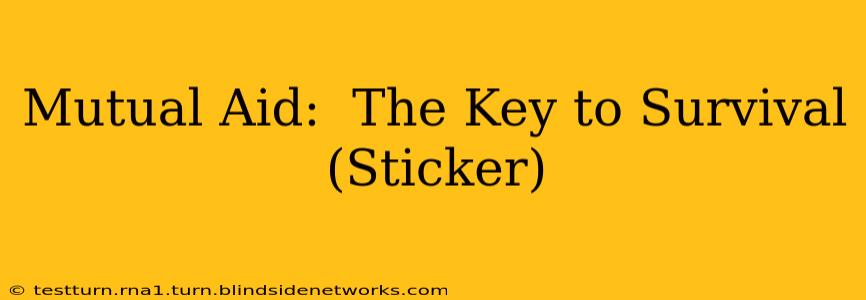Mutual Aid: The Key to Survival – A Story of Cooperation and Resilience
The small, hand-drawn sticker, a simple phrase proclaiming "Mutual Aid: The Key to Survival," caught my eye. It wasn't flashy, but it resonated with a deep-seated truth, a truth I've witnessed firsthand and pondered for years. It’s a truth that transcends the modern hustle, tapping into something primal, something essential to the human experience: our inherent capacity for cooperation.
This isn't just about charity; it's about survival, about recognizing that our interconnectedness isn't a philosophical abstraction, but a fundamental reality. This sticker, in its humble simplicity, sparked a powerful memory…
What is Mutual Aid, Really?
Mutual aid isn't a newfangled concept; it's as old as humanity itself. It's the spontaneous, informal, and reciprocal exchange of resources, support, and assistance within a community. Think of hunter-gatherer societies, where sharing food and knowledge ensured the survival of the group. It’s the neighbor lending a hand during a flood, the community organizing a soup kitchen during a crisis, the online support group offering solace and advice. It's about recognizing that our individual well-being is inextricably linked to the well-being of our collective.
How Does Mutual Aid Work in Practice?
Mutual aid is not just a philosophical idea; it's a practical approach with tangible results. It operates on a foundation of trust and reciprocity. Individuals contribute what they can, receiving support when they need it. The beauty lies in its flexibility and adaptability. It can be as simple as sharing a meal with a friend in need or as complex as establishing a community-run healthcare clinic.
Examples of Mutual Aid in Action:
- Neighborhood watch programs: These foster community vigilance and support, enhancing safety for all residents.
- Community gardens: Provide fresh produce, fostering social interaction and environmental sustainability.
- Tool libraries: Allow neighbors to borrow tools, reducing individual costs and promoting resource sharing.
- Crisis response networks: Organized groups that provide aid and support during emergencies, from natural disasters to personal crises.
Isn't Mutual Aid Just Charity?
This is a common misconception. While charity often involves a top-down approach, with resources distributed from institutions to individuals, mutual aid is fundamentally horizontal. It is built on the principles of reciprocity and shared responsibility, empowering individuals and strengthening community bonds.
How Can I Participate in Mutual Aid?
This is where the rubber meets the road. Getting involved in mutual aid is easier than you might think. Start small. Offer a helping hand to a neighbor, donate to a local food bank, or volunteer your time at a community organization. The impact of your contribution, no matter how small, can be immense. Look for existing mutual aid networks in your area – there are many, and many are looking for more volunteers.
What are the Benefits of Mutual Aid?
Beyond the obvious benefits of providing support, mutual aid fosters strong communities. It builds trust, reduces social isolation, and promotes a sense of belonging. It’s a practical demonstration of solidarity and empowerment, challenging systems of inequality and fostering resilience in the face of adversity.
That small sticker, "Mutual Aid: The Key to Survival," isn't just a catchy phrase. It’s a call to action, a reminder of our shared humanity, and a testament to the power of cooperation. It's a reminder that our survival, individually and collectively, depends on our capacity to support one another. And that capacity, my friends, is far greater than we often realize.

